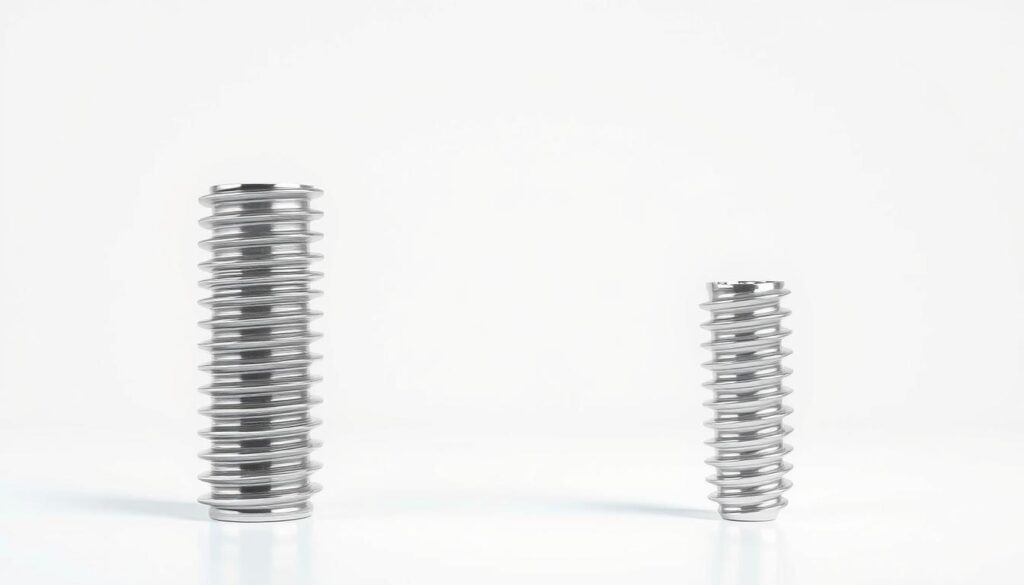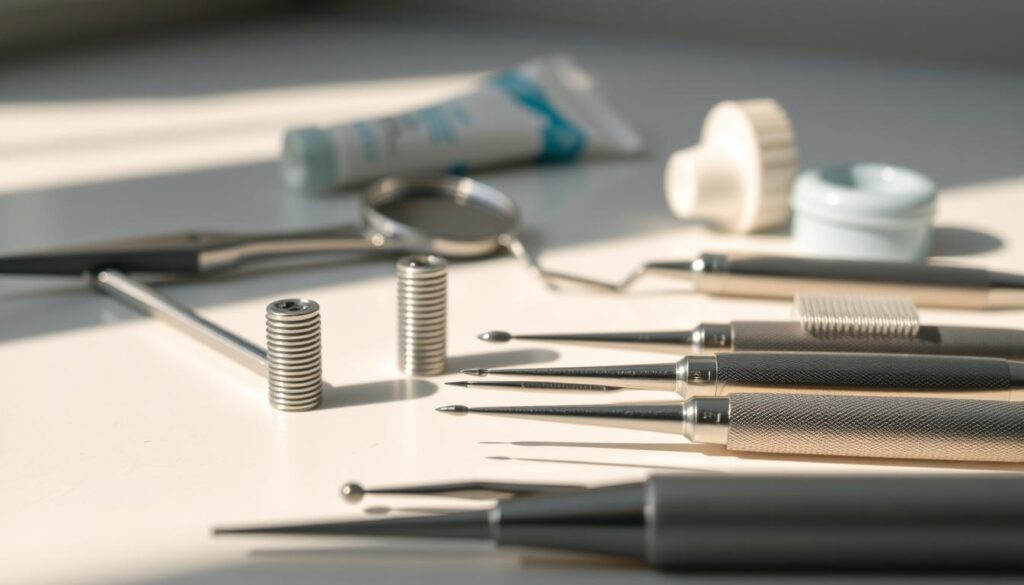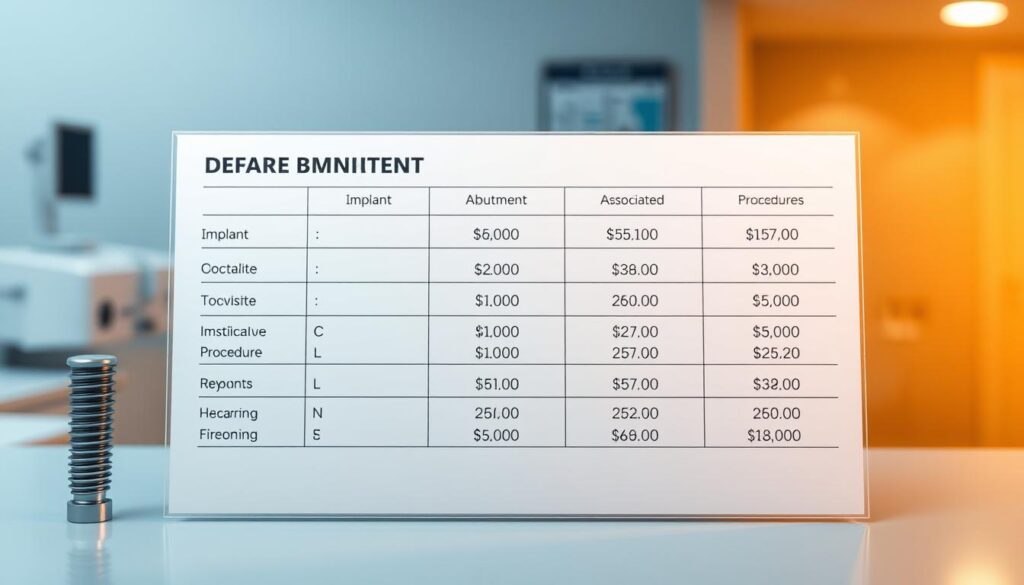Imagine having a solution for missing teeth that feels like your own and lasts forever. For many Americans, dental implants are a game-changer. They offer a way to restore your smile that’s better than dentures or bridges.
Dental implants are titanium posts that your dentist implants in your jawbone. They don’t move like dentures and don’t hurt like bridges. This method is so reliable, it works for 98% of people. One type of dental implant that’s gaining popularity is the cylindrical dental implant.
Unlike traditional screw-shaped implants, cylindrical implants have a smooth, round design that makes them easier to place in the jaw. They provide a stable foundation for a crown, bridge, or denture, making them an excellent choice for those looking for a long-term and comfortable solution.
Whether you choose a traditional or cylindrical implant, both options offer durability and function that can last a lifetime.
When you lose teeth, your jawbone starts to shrink. Dental implants act like roots, keeping your bone strong. They support your new teeth, whether you need one or a whole set. There are different types of implants for every need.
Implants do more than just look good. They let you eat, speak, and smile like before. They keep your face looking normal, unlike dentures. With the right care, implants can last for decades, improving your health and happiness.
Key Takeaways
- Dental implants achieve a 98% success rate for missing teeth replacement
- Titanium posts integrate with your jawbone to create permanent tooth roots
- Implants prevent bone loss and maintain facial structure after tooth loss
- The procedure offers superior stability compared to dentures or bridges
- Proper oral health restoration through implants can last a lifetime with regular care
- Both single tooth and full mouth reconstructions are possible with implant technology
What Are Dental Implants and How Do They Replace Missing Teeth
Dental implants are artificial tooth roots that replace missing teeth for good. They fit into your jawbone, giving support for new teeth. Unlike dentures or bridges, implants feel and work like real teeth.
Understanding the Metal Post That Replaces Tooth Roots
A dental implant starts with a small metal post in your jawbone. This post acts like a tooth root, holding the implant in place. Most implants are cylindrical to fit well with the bone.
These titanium posts are 3.5 to 6 millimeters wide and 8 to 16 millimeters long. Their shape helps them stay stable and spread out chewing forces.
The Role of Titanium in Dental Implant Surgery
Titanium is the best choice for implants because it bonds with bone. This process, called osseointegration, makes the implant strong. Titanium also grows bone around it, making it a great choice.
Why titanium is great:
- It’s safe for human tissue
- It doesn’t corrode in the mouth
- It’s strong for daily use
- It’s been used for over 50 years
Components of a Dental Implant System: Post, Abutment, and Crown
A dental implant system has three main parts. The titanium post goes in the jawbone. An abutment connects to the post. And a crown sits on top, looking like a real tooth.
| Component | Function | Material Options |
|---|---|---|
| Implant Post | Replaces tooth root | Titanium, Zirconia |
| Abutment | Connects post to crown | Titanium, Porcelain |
| Crown | Visible tooth replacement | Porcelain, Ceramic |
The Rise of Cylindrical Dental Implant Technology
Dental innovation has changed how we replace missing teeth. Cylindrical implant design is now a top choice for dentists. These implants have unique benefits that traditional designs don’t. The global cylindrical dental implant market has reached $2.5 billion in 2025, showing how popular this technology is becoming.
Traditional Screw-Shaped vs Modern Cylindrical Designs
Screw-shaped implants have been common for years. But, modern technology has brought cylindrical implants with their own advantages. Cylindrical implants have a constant diameter, like natural teeth, for better stability and bone integration.
| Feature | Screw-Shaped Implants | Cylindrical Implants |
|---|---|---|
| Shape | Tapered with threads | Uniform diameter |
| Bone Contact | Variable along length | Consistent surface area |
| Insertion Technique | Threaded placement | Press-fit or tapped |
| Primary Stability | Thread engagement | Friction fit |
Why Dental Professionals Choose Cylindrical Implants
Dentists prefer cylindrical implants for their predictable outcomes and flexibility. They work best when patients have enough bone. The uniform shape makes surgery easier, cutting down on time and pain.
Evolution of Implant Shapes in Modern Dentistry
Dental innovation keeps improving implant designs based on research and patient results. Early implants were blade-shaped, but now we focus on better bone contact and less trauma.
Cylindrical implants are a big step forward, offering better load distribution and bone integration. They’re made of titanium for safety and have a shape that transfers stress well to the bone.
Key Benefits of Choosing Dental Implants Over Traditional Options
Patients have many choices when replacing missing teeth. Dental implants offer unique benefits that make them stand out. Knowing these benefits helps patients choose the best option for their oral health and permanent tooth replacement.
Advantages Over Dentures and Bridgework
Dentures can slip during meals or conversations, but implants stay put. This means no embarrassing moments or dietary restrictions. Unlike bridges, implants don’t harm healthy teeth.
When it comes to maintenance, implants are a breeze. Dentures need special cleaning and soaking overnight. Bridges trap food in hard-to-clean spaces. Implants, on the other hand, just need regular brushing and flossing.
Long-Term Oral Health Benefits
One big advantage is jawbone preservation. Natural tooth roots keep the bone healthy. Without them, bone loss starts. Dental implants provide this vital stimulation, keeping the face looking normal.
Natural Look and Feel of Implant-Supported Teeth
Implant-supported crowns look and feel like natural teeth. Patients often forget which are implants. This makes smiling, speaking, and eating favorite foods easier. It also lets you enjoy tough or crunchy foods again.
Am I a Good Candidate for Dental Implant Surgery
Figuring out if you’re a good fit for dental implants starts with looking at a few key factors. Your dentist will check your oral and overall health to make sure implants are the best choice for you.
First, you need healthy gums without gum disease. Your jawbone also needs to be strong enough to hold the implant. If your jawbone isn’t thick enough, you might need a bone graft.
Being a good candidate for implants isn’t just about your mouth. Your overall health is also important. Some health issues and lifestyle choices can affect how well your body heals and how well the implant integrates with your bone.
| Good Candidates | May Need Additional Evaluation |
|---|---|
| Healthy gums and tissues | Active gum disease |
| Adequate jawbone density | Significant bone loss |
| Non-smokers | Heavy smokers |
| Good oral hygiene habits | Uncontrolled diabetes |
| Fully grown jawbone | Radiation therapy to head/neck |
Age isn’t a big deal when it comes to getting implants. Adults of any age can get implants if their jawbones are fully grown. But, kids and teens need to wait until their bones stop growing. This usually happens when girls are 16 and boys are 18.
“The best implant candidates commit to excellent oral hygiene and regular dental visits throughout their treatment journey.”
Your dentist will do a detailed check-up. This includes X-rays, CT scans, and looking at your medical history. This careful check makes sure implants are the right choice for you.
The Science Behind Osseointegration in Cylindrical Implants
Dental implants work because bone tissue grows into and bonds with the implant. This creates a strong base for artificial teeth to function like natural ones. Knowing how this happens shows why healing time is key for implant success.
How Jawbone Fuses With Titanium Surfaces
When a titanium implant goes into the jawbone, the body grows new bone cells that attach to it. This osseointegration process happens at a cellular level. Bone cells called osteoblasts create new bone that locks with the titanium’s rough surface.
Titanium is special because it encourages bone fusion without causing an immune response. This is unlike other materials that might be rejected by the body.
Timeline for Bone Healing and Integration
The healing time varies for each patient, but there are general patterns. Lower jaw implants usually heal faster because of denser bone.
| Healing Phase | Time Period | What Happens |
|---|---|---|
| Initial Healing | 1-2 weeks | Soft tissue heals, swelling reduces |
| Early Integration | 3-6 weeks | New bone cells begin forming |
| Primary Stability | 2-4 months | Bone fusion strengthens significantly |
| Full Integration | 3-6 months | Complete osseointegration achieved |
Factors Affecting Successful Osseointegration
Several factors can affect if an implant will bond with the jawbone. The choice between cylindrical vs tapered implant shapes can impact healing. Patient health is also crucial.
- Bone density and volume at the implant site
- Overall health conditions like diabetes or osteoporosis
- Smoking habits that reduce blood flow to healing tissues
- Proper oral hygiene during the healing period
- Following post-surgery care instructions carefully
Patients who keep their mouth clean and avoid harmful habits heal faster. Regular dentist visits help monitor the osseointegration process. This way, dentists can catch any problems early.
Comparing Cylindrical vs Tapered Implant Designs
Choosing between cylindrical and tapered dental implants is a big decision. Each type has its own benefits that affect how well the implant works and how comfortable it is for the patient. Knowing these differences helps both patients and dentists make the best choice for each situation.
Cylindrical implants have the same width all the way down, making them fit well in the bone. They look like natural tooth roots in many cases. Tapered alternatives get narrower towards the tip, like the roots of canines or incisors. Both types are important in today’s dental implants.
Recent studies have shown how these implants perform differently. Research on implant stability found tapered implants start with higher stability scores (66.9 ISQ) than cylindrical ones (62.7 ISQ). But, cylindrical implants catch up during healing, reaching 72.6 ISQ by one month, while tapered ones stay at 70.6 ISQ.
How comfortable patients feel also varies. Studies say people with cylindrical implants feel more pain in the first 24 hours. Tapered implants cause less pain right away because they fit into the bone more gently. Both types do well in the long run if chosen correctly.
The right choice depends on the bone quality, how much space there is, and what tooth needs to be replaced. Dense bone works well with cylindrical implants, while softer bone might do better with tapered ones.
The Complete Dental Implant Surgical Process
Getting dental implants is a detailed process that takes several months. It involves many steps, each one building on the last. Your dental team will help you through every step to make sure you get the best results.
Initial Consultation and Treatment Planning
Your journey starts with a detailed check-up at the dentist. Your dentist will take X-rays and 3D scans of your mouth. These help create a map of your jawbone and find the best spot for your implants.
The planning phase looks at several things, including:
- Number of teeth needing replacement
- Current jawbone density and health
- Overall oral health condition
- Your medical history and medications
Tooth Removal and Jawbone Preparation
If there are damaged teeth in the way, they are removed first. Some people need a bone graft to make their jaw stronger. This step adds time but makes your implants more stable.
Implant Placement Procedure
In the main surgery, your surgeon makes a precise hole in your jawbone. They place the titanium implant post deep into this hole. The gum tissue is then stitched closed over the implant, allowing it to heal for three to six months.
Abutment and Crown Installation Steps
After your bone fuses with the implant, you go back for the abutment. This piece connects to the implant and holds your crown. After two weeks, your dentist makes impressions for your custom crown.
The final steps are attaching your new tooth and completing your smile.
Understanding Titanium Cylinder Implant Materials
Dental implants rely on the quality of the materials used. Modern dentistry has found many biocompatible metals. But one stands out for its performance in clinics. Choosing the right material ensures your implant fits well with your bone and lasts for decades.
Why Titanium Remains the Gold Standard
Titanium is the top choice for dental implants globally. It’s light, strong, and perfect for replacing teeth. Its properties reduce jawbone stress and ensure long-lasting use.
The design of titanium implants uses these benefits well. Unlike other metals, titanium forms a protective layer when exposed to air or fluids. This layer stops corrosion and keeps the implant strong over time.
Biocompatibility and Strength Properties
Titanium is safe for your body, unlike other materials. Your body sees titanium as harmless, allowing bone cells to attach to it. This creates a strong bond between the implant and your jawbone.
| Property | Titanium Performance | Clinical Benefit |
|---|---|---|
| Tensile Strength | 550-750 MPa | Withstands chewing forces up to 200 pounds |
| Corrosion Resistance | Excellent in body fluids | Maintains integrity for 25+ years |
| Bone Integration Rate | 95-98% success | Forms permanent bond in 3-6 months |
| Allergic Reaction Risk | Less than 0.6% | Safe for nearly all patients |
Titanium’s strength-to-weight ratio is unmatched among metals. This means implants can be smaller without losing strength. This is great for patients with less bone or needing multiple implants.
One-Piece Cylindrical Implant Systems Explained
A one-piece cylindrical implant is a simpler way to replace teeth. It’s different from the usual two-piece systems. This design combines the implant post and abutment into one unit. It’s placed in one visit, making it quicker for many patients.
This system is unique compared to standard implants. With traditional implants, dentists first put in the implant post. Then, they attach a separate abutment in a second visit. But, one-piece implants have both parts connected, cutting down on surgical steps.
- The abutment portion extends above your gumline immediately after placement
- Total treatment time typically reduces by 2-3 months
- Only one surgical procedure is needed instead of two
- The visible abutment requires protection during healing
This system is great for some patients. It’s especially good for those with less bone height. It’s also good for front teeth, where looks are important right away.
| Feature | One-Piece System | Two-Piece System |
|---|---|---|
| Surgical Visits | 1 visit | 2 visits |
| Healing Time | 3-4 months | 5-7 months |
| Abutment Visibility | Visible during healing | Hidden under gums |
| Cost Range | $1,500-$2,500 | $2,000-$3,500 |
Deciding on a one-piece cylindrical implant depends on your dental needs. Your dentist will look at bone density, where the implant goes, and how it looks. They’ll decide if this design is right for you.
Bone Grafting Requirements for Dental Implants
Dental implants need a strong implant foundation to handle daily chewing. If your jawbone is too thin or weak, a bone graft is needed. This surgery builds up the bone, making it solid enough for implants.
When Bone Grafting Becomes Necessary
Several signs show you might need jawbone preparation before getting implants. Losing teeth causes the jawbone to shrink. Gum disease also damages the bone. Your dentist checks your bone with X-rays and CT scans to see if grafting is needed.
Types of Bone Graft Materials Available
There are different bone graft sources, each with its own benefits for your implant foundation:
| Graft Type | Source | Benefits | Healing Time |
|---|---|---|---|
| Autograft | Patient’s own bone | Best compatibility, fastest healing | 3-4 months |
| Allograft | Human donor bone | No second surgery site needed | 4-6 months |
| Xenograft | Animal bone (usually bovine) | Readily available, cost-effective | 6-9 months |
| Synthetic | Laboratory-created materials | No disease transmission risk | 4-8 months |
Recovery Time After Bone Augmentation
The bone grafting procedure recovery time depends on the graft size and where it’s placed. Small grafts might heal in three months, while bigger ones take up to nine months. During this time, new bone cells grow and mix with the existing bone. Your surgeon will check on your healing with X-rays before placing the implants.
Managing Pain and Recovery After Implant Surgery
After getting a dental implant, you need to take good care of it to heal right. Most people feel some pain for a few days. Your dentist will give you special instructions based on your needs.
Common symptoms after getting an implant include:
- Swelling around the gums and face
- Bruising of the skin and gums
- Discomfort at the implant site
- Minor bleeding for 24-48 hours
To manage pain, you might use over-the-counter drugs like ibuprofen or acetaminophen. Your dentist might give you stronger pain meds or antibiotics if you need them. Using ice packs on your face can help with swelling in the first 48 hours.
| Recovery Phase | Duration | Care Instructions |
|---|---|---|
| Initial Healing | 1-2 weeks | Soft foods, gentle rinsing, prescribed medications |
| Soft Tissue Recovery | 2-6 weeks | Regular oral hygiene, avoid hard foods |
| Osseointegration | 3-6 months | Normal diet, regular dental visits |
Stick to soft foods like yogurt, smoothies, and soup during recovery. Avoid hot drinks, alcohol, and smoking as they can slow healing. Most dentists use stitches that dissolve in 7-10 days. If pain or swelling gets worse after three days, call your dentist right away.
Long-Term Care and Maintenance of Your Dental Implants
Your dental implants can last a lifetime with the right care. Taking care of your new teeth means sticking to a good dental hygiene routine and regular dentist visits. The good news is that caring for implants is similar to caring for natural teeth, with just a few special considerations.
Daily Cleaning Techniques for Implant-Supported Teeth
Effective long-term care starts with your daily routine. Brush your implants twice daily with a soft-bristled toothbrush. Make sure to clean the area where the implant crown meets your gum line well.
Interdental brushes are great for cleaning around implant posts. These small brushes fit between teeth and reach spots regular toothbrushes miss. Water flossers are also a good option for implant maintenance, using gentle water pressure to remove food particles and plaque.
Professional Cleaning and Regular Checkups
Visit your dentist every six months for professional cleanings. Dental professionals use special instruments designed for implants that won’t scratch the surface. During these visits, your dentist checks the implant’s stability and examines surrounding gum tissue.
X-rays taken annually help monitor bone levels around your implants. Early detection of any issues allows for prompt treatment and protects your investment in dental hygiene.
Avoiding Habits That Can Damage Implants
Protect your implants by avoiding hard foods like ice, hard candy, and nuts. These can crack or chip the crown portion. Tobacco products stain implant crowns and increase infection risk. If you grind your teeth at night, wear a custom nightguard to prevent damage.
Common Risks and How to Minimize Complications
Dental implants have a success rate of 98%. Knowing about possible problems helps patients get ready. Most people heal well, but knowing about risks leads to better results.
Infection Prevention at the Implant Site
Infections are a big worry after dental implants. Bacteria can get into the site during or after surgery. Early signs of infection include swelling, redness, and pain Your dentist will give you antibiotics to prevent this.
Here are some ways to prevent infection:
- Rinse with antimicrobial mouthwash as directed
- Take all antibiotics as prescribed
- Don’t smoke while healing
- Keep your mouth clean
Protecting Surrounding Teeth and Tissues
Surgeons use careful techniques to avoid harming nearby teeth. *Peri-implantitis*, or inflammation around the implant, can happen if not cared for. Regular dental visits and cleanings help catch and prevent problems.
Addressing Potential Nerve Damage Concerns
Nerve damage is rare but serious. It can cause numbness or tingling in your lips, gums, or chin. Implants in the upper jaw might affect the sinuses. Skilled surgeons use detailed images to avoid these areas.
Most nerve problems get better in a few weeks. But some might need extra treatment.
Cost Considerations and Insurance Coverage Options
When planning your dental implant treatment, it’s key to know the costs. A single implant can cost between $3,000 and $6,000. This includes the post, abutment, and crown. The cost reflects the work of many specialists and the quality of materials used.
Most dental insurance plans don’t cover implants fully. They see implants as cosmetic, not essential. Some plans might cover parts of the treatment, like the crown or initial steps. It’s important to check your policy and talk to your insurance about what’s covered.
Dental offices often have flexible payment plans to help:
- Monthly payments through CareCredit or similar companies
- In-house financing with terms you can choose
- Using Health Savings Account (HSA) or Flexible Spending Account (FSA) funds
- Personal loans from banks or credit unions
The cost depends on several things. Bone grafting can add $200 to $3,000 per site. Prices also vary by location, with cities often being pricier than rural areas. Additional procedures like sinus lifts or tooth extractions will also increase the cost.
Though dental implants may seem expensive at first, they offer long-term benefits. Unlike dentures or bridges, implants can last a lifetime with proper care. Think about the cost over many years to see the real value of implants.
Success Rates and Longevity of Cylindrical Implants
Cylindrical dental implants are a top choice for tooth replacement. They have high success rates and last long. Knowing what affects their durability helps patients choose wisely for their teeth.
Factors That Influence Implant Success
Several things affect a cylindrical implant’s success. Bone quality and quantity are key for stable integration. Good oral hygiene also boosts success rates.
Smoking hurts implant success. It reduces blood flow, slowing healing and raising infection risks. Your health, including diabetes or autoimmune disorders, also plays a part.
Expected Lifespan With Proper Care
With care, cylindrical implants can last decades. Brushing and flossing daily and regular dental visits are crucial. This care helps implants last 25 years or more.
Some patients keep their implants for life. This makes implants a smart investment, despite the initial cost.
When Implant Replacement May Be Needed
Implant replacement is rare but can happen. Gum disease or trauma can damage implants. If initial integration fails, the implant is removed and the site is cleaned before trying again.
Conclusion
Cylindrical dental implants do more than just fill gaps in your teeth. They offer a lasting fix for both looks and function. This means you can eat, speak, and smile without worry again.
The special shape of these implants helps them stay in place well. It also helps them blend with your bone, making them a top pick for dentists everywhere.
Investing in dental implants can change your life for years to come. Unlike dentures or bridges, implants keep your jawbone strong. They work like real teeth roots, keeping your face looking good.
With the right care, these implants can last forever. They also help protect your other teeth from damage.
Starting your smile makeover means talking to skilled dentists. They’ll look at your needs and plan a treatment just for you. Places like Pristine Family & Cosmetic Dentistry help every step of the way.
Choosing cylindrical implants means you’re picking a reliable option. It uses the latest tech, expert surgery, and long-term health benefits.





